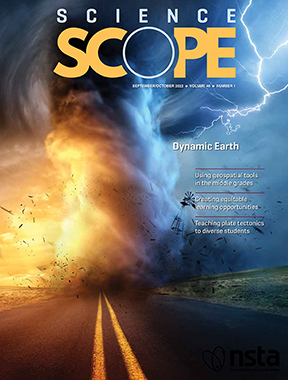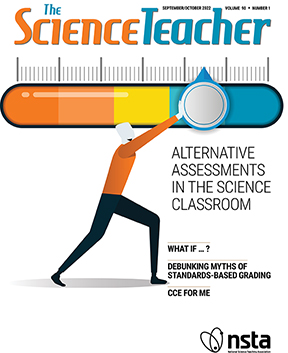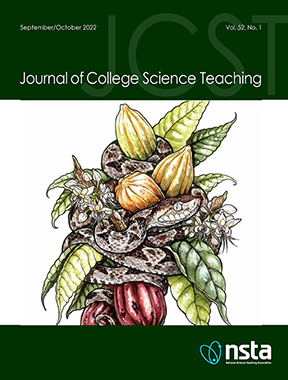teaching through trade books
Starting With Science
Science and Children—September/October 2022 (Volume 60, Issue 1)
By Christine Anne Royce
From the Field: Freebies and Opportunities for Science and STEM Teachers, September 6, 2022
By Debra Shapiro

Tech Talk
Joyful Science
Science and Children—September/October 2022 (Volume 60, Issue 1)
By Heather Pacheco-Guffrey
The early years
Preschoolers’ Science Learning Can Be Joyful—Using a Play-Based, Project Approach
Science and Children—September/October 2022 (Volume 60, Issue 1)
By Shelly Lynn Counsell
Editor's Note
Joyful Science
Science and Children—September/October 2022 (Volume 60, Issue 1)
By Elizabeth Barrett-Zahn

Volume 46, Number 1
Dynamic Earth

Volume 46, Number 1
Dynamic Earth

Volume 46, Number 1
Dynamic Earth

Volume 90, Number 1
Alternative Assessments in the Science Classroom
When I say “assessments,” what immediately comes to your mind? Tests, quizzes, and exams? Does it always have to be that way?
As you know, there are two main categories of assessments.

Volume 90, Number 1
Alternative Assessments in the Science Classroom
When I say “assessments,” what immediately comes to your mind? Tests, quizzes, and exams? Does it always have to be that way?
As you know, there are two main categories of assessments.

Volume 90, Number 1
Alternative Assessments in the Science Classroom
When I say “assessments,” what immediately comes to your mind? Tests, quizzes, and exams? Does it always have to be that way?
As you know, there are two main categories of assessments.
Research & Teaching
Cross-Disciplinary Learning
A Framework for Assessing Application of Concepts Across Science Disciplines
Journal of College Science Teaching—September/October 2022 (Volume 52, Issue 1)
By Emily Borda, Todd Haskell, and Andrew Boudreaux
We propose cross-disciplinary learning as a construct that can guide instruction and assessment in programs that feature sequential learning across multiple science disciplines. Cross-disciplinary learning combines insights from interdisciplinary learning, transfer, and resources frameworks and highlights the processes of resource activation, transformation, and integration to support sense-making in a novel disciplinary context by drawing on knowledge from other prerequisite disciplines. In this article, we describe two measurement approaches based on this construct: (a) a paired multiple choice instrument set to measure the extent of cross-disciplinary learning; and (b) a think-aloud interview approach to provide insights into which resources are activated, and how they are used, when making sense of an unfamiliar phenomenon. We offer implications for program and course assessment.
We propose cross-disciplinary learning as a construct that can guide instruction and assessment in programs that feature sequential learning across multiple science disciplines. Cross-disciplinary learning combines insights from interdisciplinary learning, transfer, and resources frameworks and highlights the processes of resource activation, transformation, and integration to support sense-making in a novel disciplinary context by drawing on knowledge from other prerequisite disciplines.
We propose cross-disciplinary learning as a construct that can guide instruction and assessment in programs that feature sequential learning across multiple science disciplines. Cross-disciplinary learning combines insights from interdisciplinary learning, transfer, and resources frameworks and highlights the processes of resource activation, transformation, and integration to support sense-making in a novel disciplinary context by drawing on knowledge from other prerequisite disciplines.
Research & Teaching
Recent Developments in Classroom Observation Protocols for Undergraduate STEM
An Overview and Practical Guide
Journal of College Science Teaching—September/October 2022 (Volume 52, Issue 1)
By Joan Esson, Paul Wendel, Anna Young, Meredith Frey, and Kathryn Plank
Over the past decade, researchers have developed several teaching observation protocols for use in higher education, such as the Teaching Dimensions Observation Protocol (TDOP), Classroom Observation Protocol for Undergraduate STEM (COPUS), Practical Observation Rubric to Assess Active Learning (PORTAAL), and Decibel Analysis for Research in Teaching (DART). Choosing a protocol for a particular need can seem daunting. In this article, we describe these protocols—including characteristics such as theoretical lens, disciplinary expertise required, complexity, level of inference, type of behavior recorded, training time required for implementation, and data output—and discuss the strengths and weaknesses of each protocol for different uses. This article will aid anyone in choosing effective observation tools for their particular needs, including instructors who want to address specific questions about their own teaching and researchers who are studying teaching and learning.



